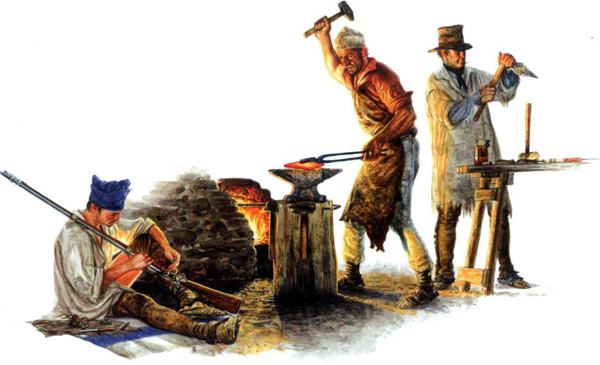Several Mandan men from Mitutanka briefly visit Fort Mandan, and Lewis describes the blacksmiths as a ‘happy resource’. Elsewhere, Clark‘s large group hunts near present Square Butte Creek, North Dakota.
Square Butte Creek
3rd day
Camped on a Sand point near the mouth of a Creek on the S W. Side we Call hunting Creek
—William Clark (recorded on 13 February 1805)
Indian Visitors
visited by many of the natives among others the Big white, the Coal [Sho-ta-har-ro-ra] , big-man [Oh-he-nar], hairy horn and the black man, I smoked with them, after which they retired, a deportment not common, for they usually pester us with their good company the ballance of the day
—Meriwether Lewis
Blacksmiths, a Happy Resource
the blacksmith’s have proved a happy resoce to us in our present situation as I believe it would have been difficult to have devised any other method to have procured corn from the natives. the Indians are extravegantly fond of sheet iron of which they form arrow-points and manufacter into instruments for scraping and dressing their buffaloe robes—
—Meriwether Lewis
Cutting Up the Galley Stove
I permited the blacksmith to dispose of a part of a sheet-iron callaboos [Nicholas Biddle: camboose/Stove] which had been nearly birnt out on our passage up the river, and for each piece about four inches square he obtained from seven to eight gallons of corn from the natives who appeared extreemly pleased with the exchange—
—Meriwether Lewis
Fort Mandan Observations
Observed equal altitude of the
with Sextant artifical horizon with water
I do not place great confidence in these observations, as the person who took the time was not much accustomed to the business. Capt. Clark was absent
—Meriwether Lewis
Weather Diary
State of the Ther. at rise
Weather Wind at rise
Thermt. at 4 oCk. P.M. Weather Wind at 4 oCk. P.M. River 4 [below 0] fair N W 12 [above 0] fair W raise ½ in. —Meriwether Lewis[1]To assist the reader, the editor of this web page has omitted the date column, merged the “State of the River at
rise” columns, and spelled out some abbreviations.
Experience the Lewis and Clark Trail
The Lewis and Clark Trail Experience—our sister site at lewisandclark.travel—connects the world to people and places on the Lewis and Clark Trail.
Plan a trip related to February 6, 1805:

Fort Mandan is a High Potential Historic Site along the Lewis and Clark National Historic Trail managed by the U.S. National Park Service. The North Dakota Department of Parks and Recreation manages a modern reconstruction and the Lewis and Clark Interpretive Center located at US Hwy 83 and ND Hwy 200A.
Knife River Indian Villages National Historic Site is a High Potential Historic Site along the Lewis and Clark National Historic Trail managed by the U.S. National Park Service. A unit of the National Park System, the site is located at 564 County Road 37, one-half mile north of Stanton, North Dakota. It has exhibits, trails, and a visitor center.
Notes
| ↑1 | To assist the reader, the editor of this web page has omitted the date column, merged the “State of the River at  rise” columns, and spelled out some abbreviations. rise” columns, and spelled out some abbreviations. |
|---|



